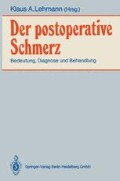Zusammenfassung
Die Akupunktur, die „Sticheltherapie der alt-chinesischen Medizin“ [26], stellt eine Form der Hautreiz- und Segmenttherapie dar. Dünne Metallnadeln werden in spezielle Akupunkturpunkte eingeführt, die auf empirisch herausgefundenen Leitbahnen (den sog. Meridianen) liegen. Die Akupunkturpunkte werden dadurch mechanisch stimuliert; aber auch andere Reizformen (elektrischer Strom, Laser oder Hitzeeinwirkung (Moxibustion) sind möglich. In der westlichen Medizin wird die Akupunktur bei unterschiedlichen Erkrankungen angewendet. Leidlich gesicherte Therapieerfolge stammen z. B. von der Therapie einiger chronischer Schmerzzustände [6, 7, 22, 24, 25]. Die sog. Akupunkturnarkose oder Elektrostimulationsanästhesie hat sich demgegenüber nicht durchsetzen können [3, 19, 21, 28]. Die Wirkmechanismen der Akupunktur zur Schmerzbehandlung sind nicht gesichert. Diskutiert werden hemmende Wirkungen auf schmerzleitende Systeme im Rückenmark über die Stimulation sensibler Afferenzen und/oder endogener schmerzhemmender Mechanismen (vgl. 2.1). Es bestehen Ähnlichkeiten zur Wirkung der transkutanen Nervenstimulation (vgl. 3.3.1).
Access this chapter
Tax calculation will be finalised at checkout
Purchases are for personal use only
Preview
Unable to display preview. Download preview PDF.
Literatur
Amit Z, Galina ZH (1986) Stress-induced analgesia: adaptive pain suppression. Physiol Rev 66: 1091–1121
Bhattacharya A, Nayak V (1987) Electroacupuncture vs. transcutaneous nerve stimulation in the management of post operative pain. Pain 30 (Suppl): S149
Christensen PA, Noreng M, Andersen PE, Nielsen JW (1989) Electroacupuncture and postoperative pain. Br J Anaesth 62: 258–262
Copolov DL, Helme RD (1983) Enkephalins and endorphins. Clinical, pharmacological and therapeutic implications. Drugs 26: 503–519
Dundee JW, Milligan KR, McKay AC (1988) Influence of intraoperative acupuncture and droperidol on postoperative emesis. Br J Anaesth 61: 116P - 117 P
Fischer MV (1982) Akupunkturtherapie in der Anaesthesieambulanz des Unversitätsklinikums Heidelberg. Anaesthesist 31: 25–32
Frost EAM, Hsu CY, Sadowsky D (1976) Acute and chronic pain–a study of the comparative values of acupuncture therapy. Adv Pain Res Ther 1: 823–829
Frost EAM, Kim YI, Hsu CY, Orkin LR (1976) Acupuncture for acute postoperative pain relief. Adv Pain Res Ther 1: 831–837
Ghaly RG, Lynas AGA, Dundee JW (1987) Acupuncture also reduces the emetic effects of pethidine. Br J Anaesth 59: 135 P
Grabow L, Hein A, Thiel W (1986) Prämedikation, postoperativer Schmerz und Schmerzbehandlung. Schmerz-Pain-Douleur 7: 106–112
Grabow L, Thiel W, Hendrikx B, Hein A, Schilling E (1986) Alternativen für die postoperative Schmerzbehandlung. Dtsch Ärzteblatt 83: 1361–1366
Handwerker HO (1989) Physiologische Hypothesen über die Akupunkturhypalgesie. Schmerz-Pain-Douleur 10: 1–6
He L, Lu R, Zhuang S, Zhang X, Pan X (1985) Possible involvement of opioid peptides of caudate nucleus in acupuncture analgesia. Pain 23: 83–93
He L (1987) Involvement of endogenous opioid peptides in acupuncture analgesia. Pain 31: 99–121
Jinglan W, Xitao W, Yan F, Yilin W (1989) Effects of electroacupuncture and naloxone on the pain thresholds and pituitary I1-endorphin in guinea pigs. Schmerz-Pain-Douleur 10: 19–22
Kreitler S, Kreitler H, Carasso R (1987) Cognitive orientation as predictor of pain relief following acupuncture. Pain 28: 323–341
Lebars D, Dickenson AH, Besson JM (1979) Diffuse noxious inhibitory controls (DNIC). I. Effects on dorsal horn convergent neurons in the rat. Pain 6: 283–304
Liu X, Zhu B, Zhang S (1986) Relationship between electroacupuncture analgesia and descending pain inhibitory mechanisms of nucleus raphe magnus. Pain 24: 383–396
Lüben V, Herget HF, Kramer M, Patschke D (1981) Hämodynamische Untersuchungen unter Naloxone während der Elektrostimulationsanalgesie ( ESA) als Beitrag zur Endorphintheorie. Anaesth Intensivther Notfallmed 16: 180–183
Lynas AGA, Ghaly RG, Dundee JW (1986) Acupuncture reduced the emetic effects of nalbuphine premedication. Br J Anaesth 58: 1331P - 1332 P
Ott E, Martin E, Kuppe h (1978) Does electroanaesthesia reduce the need for analgesics in surgery? In: Wageneder EM, Germann RH (eds) Electrotherapeutic Sleep and Electroanaesthesia. DBV Verlag TU, Graz, pp 277–284
Pauser G (1986) Akupunktur. Klin Anaesthesiol Intensivther 32: 134–141
Pomeranz B, Chiu D (1976) Naloxone blockade of acupuncture analgesia: endorphin implicated. Life Sci 19: 1557–1562
Pothmann R (1986) Möglichkeiten der Akupunktur in der Schmerztherapie. Dtsch Krankenpflege-Zeitschrift 39: 168–172
Richardson PH, Vincent CA (1986) Acupuncture for the treatment of pain: a review of evaluative research. Pain 24: 15–40
Roche Lexikon Medizin. Urban and Schwarzenberg, 2. Auflage 1987
Sjölund B, Terenius L, Eriksson M (1977) Increased cerebrospinal fluid levels of endorphins after electro-acupuncture. Acta Physiol Scand 100: 382–384
Stellpflugh (1978) Stress during surgery performed under combined electroacupuncture and enflurane anaesthesia as measured by serum cortisol concentrations. In: Wageneder EM, Germann RH (eds) Electrotherapeutic Sleep and Electroanaesthesia. DBV-Verlag TU, Graz, pp 411–418
Vincent CA, Richardson PH (1986) The evaluation of therapeutic acupuncture: concepts and methods. Pain 24: 1–13
Willer JC, Dehen H, Cambier J (1981) Stress-induced analgesia in humans: endogenous opioids and naloxone-reversible depression of pain reflexes. Science 212: 689–691
Yan Z, Zonglianh (1989) The peripheral pathway of afferent impulses in traditional acupuncture analgesia. Schmerz-Pain-Douleur 10: 15–18
Editor information
Editors and Affiliations
Rights and permissions
Copyright information
© 1990 Springer-Verlag Berlin Heidelberg
About this chapter
Cite this chapter
Horrichs-Haermeyer, G., Lehmann, K.A. (1990). Akupunktur. In: Lehmann, K.A. (eds) Der postoperative Schmerz. Springer, Berlin, Heidelberg. https://doi.org/10.1007/978-3-662-06539-6_24
Download citation
DOI: https://doi.org/10.1007/978-3-662-06539-6_24
Publisher Name: Springer, Berlin, Heidelberg
Print ISBN: 978-3-662-06540-2
Online ISBN: 978-3-662-06539-6
eBook Packages: Springer Book Archive

